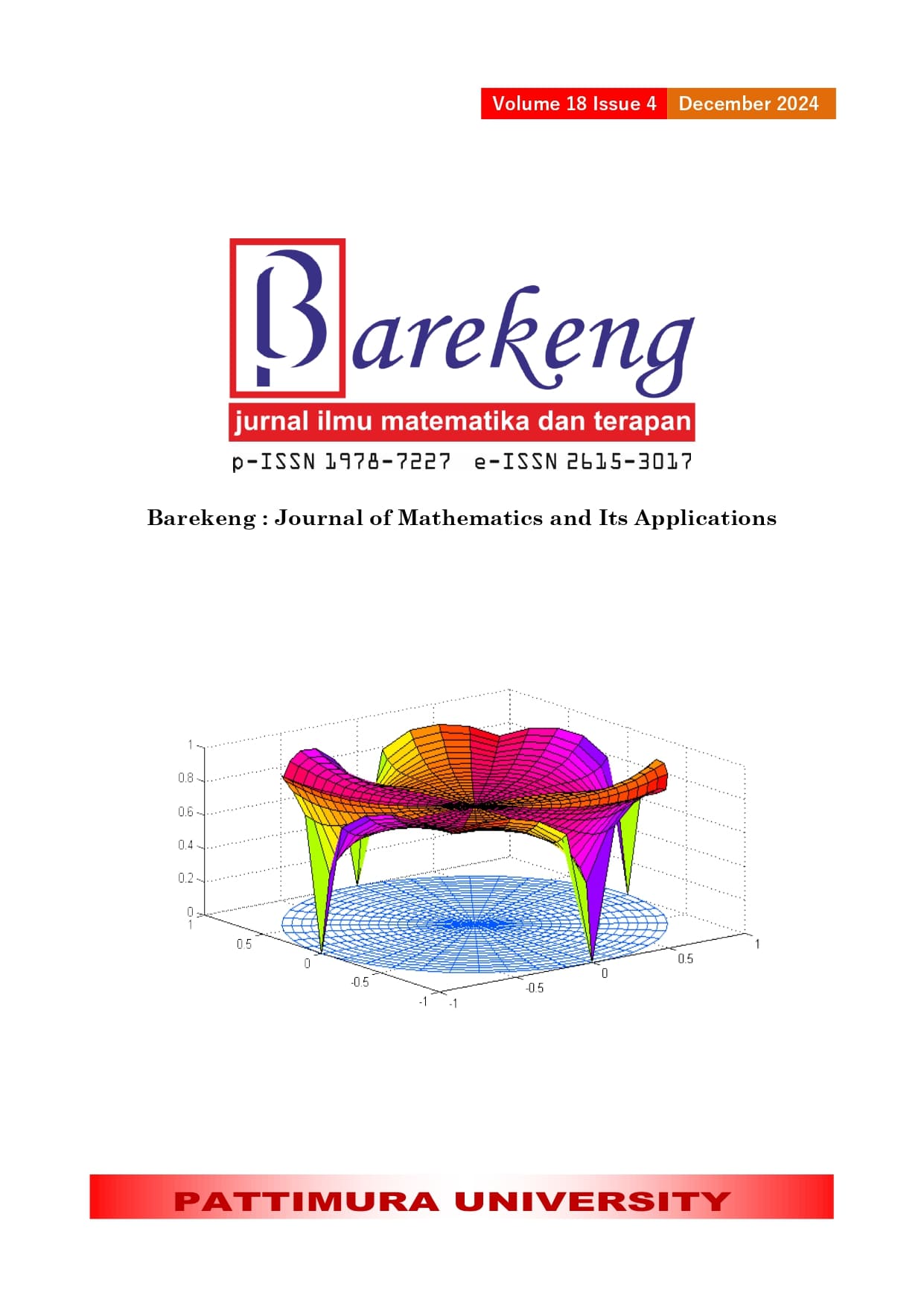MODELING LONGITUDINAL FLOOD DATA IN WEST SUMATRA USING THE GENERALIZED ESTIMATING EQUATION (GEE) APPROACH
Abstract
Flooding is one of the many natural disasters that often hit Indonesia. In July 2023, three areas in West Sumatra experienced floods and landslides which caused damages and even 2 missing victims. Since November 16th, 2023, 8 hamlets in Meranti Village, Landak District, West Sumatra have been inundated by floods which affected families and many public facilities. This research uses data from West Sumatra Province Central Statistics Agency. The data used is 2014, 2018 and 2021. The response variable used is the number of villages/sub-districts experiencing natural disasters according to district/city ( ). The predictor variables used are regional topography , the number of water channels such as rivers, reservoirs, etc. , the number of fields cleared through burning , the number of villages/sub-districts in C excavation area , and the number of dumpsters . This research uses Negative Binomial Regression with the Generalized Estimating Equation (GEE) approach. In the Poisson regression test, the QIC value based on Independent Working Correlation Structure (WCS) is with deviance value of , degree of freedom of , and dispersion score of 4,6144. Because the dispersion value is greater than 1, it can be concluded that there is overdispersion. Because there is more than one overdispersion, it is overcome by using negative binomial. The results of parameter estimation using negative binomial regression based on Independent WCS showed that only one variable was significant, which is the number of fields cleared through burning with deviance value of , degrees of freedom of and a QIC of . Negative Binomial regression model that was formed is ). From the two regression models used, namely Poisson and negative binomial, it was found that the negative binomial regression model was the best model because it had the lowest QIC value of .
Downloads
References
S. Hardiyanto and D. Pulungan, "Komunikasi Efektif Sebagai Upaya Penanggulangan Bencana Alam di Kota Padangsidimpuan.," Jurnal Interaksi: Jurnal Ilmu Komunikasi, pp. 3(1), 30-39, 2019.
A. Rosyidie, "Banjir: fakta dan dampaknya, serta pengaruh dari perubahan guna lahan.," Jurnal perencanaan wilayah dan kota, pp. 24(3), 241-249, 2013.
D. Ramadhan, "Antara News," BNPB: Tiga wilayah di Sumatera Barat dilanda banjir dan longsor, 14 Juli 2023. [Online]. Available: https://www.antaranews.com/berita/3635613/bnpb-tiga-wilayah-di-sumatera-barat-dilanda-banjir-dan-longsor#mobile-src.
Antara, "tempo.co," Ribuan Warga di Wilayah Ini Terdampak Banjir hingga Mengungsi, 20 November 2023. [Online]. Available: https://tekno.tempo.co/read/1798883/ribuan-warga-di-wilayah-ini-terdampak-banjir-hingga-mengungsi.
panda, Menghadapi Bencana Banjir: Upaya Pengelolaan dan Mitigasi Risiko untuk Masyarakat Desa, 01 06 2024. [Online]. Available: https://www.panda.id/menghadapi-bencana-banjir-upaya-pengelolaan-dan-mitigasi-risiko-untuk-masyarakat-desa/. [Accessed 19 08 2024].
A. Setiawan, "Regresi Poisson Menggunakan Generalized Estimating Equation (Studi Kasus: Data Longitudinal Frekuensi Terjadinya Banjir Di Jawa Timur Tahun 2011- 2013).," in Master’s Thesis, Institut Teknologi Sepuluh Nopember, Surabaya, 2017.
L. Wu, Mixed Effect Models for Complex data, New York: CRC Press, Taylor and Francis Group, 2010.
R. Naelu, "Karakteristik Penduga Parameter Generalized Estimating Equation (GEE) pada Data Longitudinal," in Skripsi, Fakultas Matematika dan Ilmu Pengetahuan Alam, Universitas Lampung, Lampung, 2016.
X. Liu, Methods and applications of longitudinal data analysis, London: Elsevier , 2015.
M. Wang, L. Kong, Z. Li and L. Zhang, "Covariance estimators for generalized estimating equations (GEE) in longitudinal analysis with small samples," Statistics in medicine, vol. 35, no. 10, pp. 1706-1721, 2016.
Danardono, Analisis Data Longitudinal, Yogyakarta: Gadjah Mda University Press., 2015.
T. W. Utami, "Analisis regresi binomial negatif untuk mengatasi overdispersion regresi poisson pada kasus demam berdarah dengue," Jurnal Statistika Universitas Muhammadiyah Semarang, vol. 1, no. 2, 2013.
D. E. Ashari, "Faktor-Faktor yang Mempengaruhi Banyaknya Pneumonia Balita Di Jawa Timur Menggunakan Generalized Poisson Regression (GPR) dan Negative Binomial Regressiion (NBR)," Institut Teknologi Surabaya, 2014.
N. Shrestha, "Detecting multicollinearity in regression analysis," American Journal of Applied Mathematics and Statistics, vol. 8, no. 2, pp. 39-42, 2020.
A. Crisci, L. D'Ambra and V. Esposito, "A generalized estimating equation in longitudinal data to determine an efficiency indicator for football teams," Social Indicators Research, vol. 146, no. 1-2, pp. 249-261, 2019.
L. H. Vanegas and L. M. Rondon, "A data transformation to deal with constant under/over-dispersion in Poisson and binomial regression models," Journal of Statistical Computation and Simulation, vol. 90, no. 10, pp. 1811-1833, 2020.
P. A. Omar and T. M. Hussian, "Fitting of Generalized Poisson Regression and Negative Binomial Regression models for Analyzing of Count Time Series Event," Polytechnic Journal of Humanities and Social Sciences, vol. 4, no. 2, pp. 116-126, 2023.
Y. Setyawan, K. Suryowati and D. Octaviana, "Application of Negative Binomial Regression Analysis to Overcome the Overdispersion of Poisson Regression Model for Malnutrition Cases in Indonesia," Parameter: Journal of Statistics, vol. 2, no. 2, pp. 1-9, 2022.
Copyright (c) 2024 Alfi Nur Nitasari, Andini Sa'idah, Nurin Faizun, Kezia Eunike Darmawan, Marfa Audilla Fitri, Nur Chamidah

This work is licensed under a Creative Commons Attribution-ShareAlike 4.0 International License.
Authors who publish with this Journal agree to the following terms:
- Author retain copyright and grant the journal right of first publication with the work simultaneously licensed under a creative commons attribution license that allow others to share the work within an acknowledgement of the work’s authorship and initial publication of this journal.
- Authors are able to enter into separate, additional contractual arrangement for the non-exclusive distribution of the journal’s published version of the work (e.g. acknowledgement of its initial publication in this journal).
- Authors are permitted and encouraged to post their work online (e.g. in institutional repositories or on their websites) prior to and during the submission process, as it can lead to productive exchanges, as well as earlier and greater citation of published works.






1.gif)



